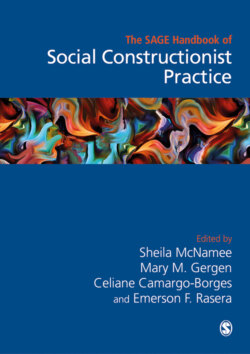Читать книгу The Sage Handbook of Social Constructionist Practice - Группа авторов - Страница 123
На сайте Литреса книга снята с продажи.
Material-Discursive Practice
ОглавлениеIn transmaterial worlding, we understand researching linguistic practice as a form of mattering. There are no final conclusions – though there may be useful knowledge – and the need to attempt to describe journeys of knowing in which contextualised, situated ways of knowing extend or close down ways of accounting and the potential for transformation of participants. Transmaterial worlding is a process of moving, constructing, deconstructing, reconstructing and reviving stories which include the voices of those normally heard through privileged channels and the voices of marginalised, silenced or exterminated peoples, places, human and non-human, across many matters, across context, across time. Inevitably, material changes depending on where the describer is standing, how they are dressed, how the light is falling or arranged (Simon and Salter, 2019). Any ‘apparatus’ that is used, is part of the research and therefore part of the world that is being co-constructed (Barad, 2007). Discursive mattering is inevitably influenced by the limits of the describer's own apparatus – cultural lenses and filters which frequently result in a reproductive mattering of dominant heteronormative, white supremacist narratives and practices (Chen, 2012; Pillow, 2019).
How we configure ‘other’ people, places or things can happen through taking an aboutness position and become an act of colonisation in attributing meaning or interpreting meaning. Acts of colonisation separate the knower from their knowing and know-how, leading us into binary constructions of ‘us’ and ‘them’, and stories of people who apparently know nothing. Histories are lost and communities fractured. People are silenced in a myriad of ways. This has resulted in unmitigated loss of indigenous knowledge and contextual know-how. Colonised groups of people who have been researched have had all manner of falsehoods, intentional or otherwise, written about them which have often led to the development of policies which have served to oppress further and render invisible issues of concern facing those communities (Clifford and Marcus, 1986; Salter, 2015, 2017b; McCarthy and Byrne, 2007; Pillow, 2019; Richardson/Kinewesquao, 2018; Simon, 1998; Tuhiwai Smith, 1999; Visweswaran, 1994). This has resulted in catastrophic changes in societies and land ownership, such as loss of rainforests, sustainable communities, homelands, dunes, clean air, uncontaminated sites, the ozone layer and much, much more. So it becomes an ethical imperative to ask, ‘What and who are in focus?’ and ‘Why?’ and ‘How can other silenced voices or erased matters be animated, rendered audible through our research?’
Living in a transmaterial world, parts of which we have largely ignored messages from, we need to learn how to listen to relational communications in transmaterial relationships. Transmaterial worlding, as inquiry, is a process of co-constructing new ways of understanding, meaning-making and ways of being across human and non-human activity, motivated by a concern for social justice with the aim of challenging oppression, improving lives and promoting equality (McCarthy and Byrne, 2007; Reynolds, 2014, 2019; Salter, 2018). Transmaterial worlding as inquiry is not only a means of assessing and theorising what is happening, it involves doing something to improve the living conditions of people and the sustainability of our human and non-human environments and it means engaging in transformative activities.
